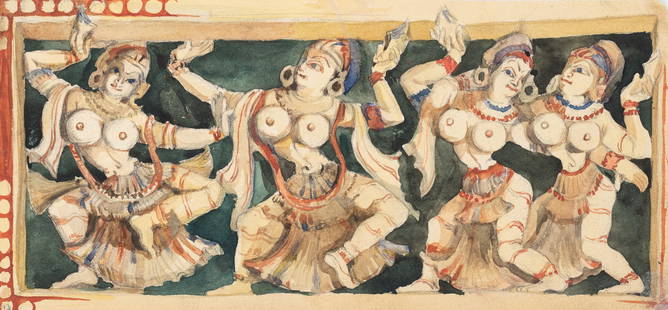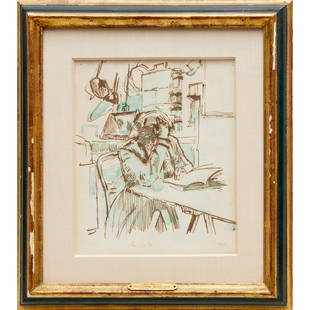
Calcutta School Watercolor, Indian Paradise-Flycatcher
Similar Sale History
View More Items in Drawings![Company School Watercolor, Melon, Cocoa, and Exotic Fruits, with Insect and Quail: COMPANY SCHOOL (19th-Century). [Melon, Cocoa, and Exotic Fruits, with Insect and Quail] Pencil, wash and watercolor on paper. Mount with washed borders. c. 1820 from A Collection of Drawings of Indian](https://p1.liveauctioneers.com/1968/266046/138912563_1_x.jpg?height=310&quality=70&version=1666627499)
Related Drawings
More Items in Indian Drawings
View MoreRecommended Art
View More



Item Details
Description
THE CALCUTTA SCHOOL (Early 19th Century).
Indian Paradise-Flycatcher [An Asian Paradise-Flycatcher, Terpsiphone paradisi.] Male.
Pen and black and grey ink, watercolor and bodycolor with gum arabic, watermark Strasburg Lily.
With inscription ‘Shah Bulbull [sic]. See Folios 47. 86. &. 87.’ (lower right) and with a further inscription ‘Female’ (upper center)
c.1810.
17 3/4" x 12" sheet.
Provenance: Niall Hobhouse collection. The Hobhouse collection was known to have a number of supreme examples of company school works including several works prepared by Bhawani Das and prepared for Lady Impey.
Until 2015, the Indian paradise flycatcher, Blyth’s paradise flycatcher, and the Amur paradise flycatcher were all considered conspecific and together called Asian paradise flycatcher. Corvus paradisi was the scientific name proposed by Linnaeus in 1758. Early naturalists thought that this bird spent the first three years chestnut-colored and then on the third or fourth autumn molt began to lose chestnut feathers that came back in white and permanently remained in this state. However, later research confirmed that only the male birds turn white, not the females. Males have elongated central tail feathers and black and rufous plumage in some populations, while others have white plumage. Females are short-tailed with rufous wings and a blackhead. Thus, the artist incorrectly notes, “female.”
This bird can be found in India’s wooded forest areas as far east as Nepal in the Himalayas and the Brahmaputra river in the plains. To the west, this species extends into Afghanistan, and to the north into Turkestan. In Kashmir and other parts of the Himalayas, it is found in the summer up to 9000 feet. They feed on insects under thick twig trees. Their distinctive noisy sharp shrieks, ‘che-che’ or ‘che-chew’ or sharp ‘zweet zweet’ allow their calls to break with their surroundings’ heavy thicket.
‘Bulbul’ was a term to describe very fine songbirds in British India generally. This distinction of ‘Shah Bulbull’ (sic) is to draw attention to this bird’s mystical heritage within the area where it was likely painted and perhaps the painter’s religion.
Bulbul Shah was the first Suhrawardi Sufi to have entered Kashmir. He is best known for converting the king and increasing the prestige of Islam in the Kashmir valley. Bulbul Shah led a life of complete self-abnegation and preached against superstitions widely prevalent amongst his period’s Kashmiris. He showed great love towards the oppressed. The associations between the Shah and the bird stem from a mystical legend. The Shah’s birthname was Hazrat Syed Sharaf- ud- Din. One day while making an ablution near a stream, he saw a bulbul bird on a tree singing beautifully, suddenly the bird flew towards the sky. The Shah flew after the bird and caught hold of the bird and flew down into his cottage, and the bird vanished. In the episode, the Shah stated that the bird was not a bird, but his soul flew towards the sky, and he followed it and caught hold of his soul. While the Shah died in 1327, he is remembered as one of Kashmir’s most prominent figures. All the historians seem to agree Bulbul Shah was the first saint who sowed the seeds of Islam in Kashmir.
Indian Paradise-Flycatcher [An Asian Paradise-Flycatcher, Terpsiphone paradisi.] Male.
Pen and black and grey ink, watercolor and bodycolor with gum arabic, watermark Strasburg Lily.
With inscription ‘Shah Bulbull [sic]. See Folios 47. 86. &. 87.’ (lower right) and with a further inscription ‘Female’ (upper center)
c.1810.
17 3/4" x 12" sheet.
Provenance: Niall Hobhouse collection. The Hobhouse collection was known to have a number of supreme examples of company school works including several works prepared by Bhawani Das and prepared for Lady Impey.
Until 2015, the Indian paradise flycatcher, Blyth’s paradise flycatcher, and the Amur paradise flycatcher were all considered conspecific and together called Asian paradise flycatcher. Corvus paradisi was the scientific name proposed by Linnaeus in 1758. Early naturalists thought that this bird spent the first three years chestnut-colored and then on the third or fourth autumn molt began to lose chestnut feathers that came back in white and permanently remained in this state. However, later research confirmed that only the male birds turn white, not the females. Males have elongated central tail feathers and black and rufous plumage in some populations, while others have white plumage. Females are short-tailed with rufous wings and a blackhead. Thus, the artist incorrectly notes, “female.”
This bird can be found in India’s wooded forest areas as far east as Nepal in the Himalayas and the Brahmaputra river in the plains. To the west, this species extends into Afghanistan, and to the north into Turkestan. In Kashmir and other parts of the Himalayas, it is found in the summer up to 9000 feet. They feed on insects under thick twig trees. Their distinctive noisy sharp shrieks, ‘che-che’ or ‘che-chew’ or sharp ‘zweet zweet’ allow their calls to break with their surroundings’ heavy thicket.
‘Bulbul’ was a term to describe very fine songbirds in British India generally. This distinction of ‘Shah Bulbull’ (sic) is to draw attention to this bird’s mystical heritage within the area where it was likely painted and perhaps the painter’s religion.
Bulbul Shah was the first Suhrawardi Sufi to have entered Kashmir. He is best known for converting the king and increasing the prestige of Islam in the Kashmir valley. Bulbul Shah led a life of complete self-abnegation and preached against superstitions widely prevalent amongst his period’s Kashmiris. He showed great love towards the oppressed. The associations between the Shah and the bird stem from a mystical legend. The Shah’s birthname was Hazrat Syed Sharaf- ud- Din. One day while making an ablution near a stream, he saw a bulbul bird on a tree singing beautifully, suddenly the bird flew towards the sky. The Shah flew after the bird and caught hold of the bird and flew down into his cottage, and the bird vanished. In the episode, the Shah stated that the bird was not a bird, but his soul flew towards the sky, and he followed it and caught hold of his soul. While the Shah died in 1327, he is remembered as one of Kashmir’s most prominent figures. All the historians seem to agree Bulbul Shah was the first saint who sowed the seeds of Islam in Kashmir.
Buyer's Premium
- 25%
Calcutta School Watercolor, Indian Paradise-Flycatcher
Estimate $25,000 - $45,000
1 bidder is watching this item.
Shipping & Pickup Options
Item located in New York, NY, usOffers In-House Shipping
Local Pickup Available
Payment

TOP



























![Indian School Watercolor, The Adjutant from the East Indies - Sunda Marabu: INDIAN SCHOOL (Late 18th/ Early 19th Century). The Adjutant from the East Indies [Sunda Marabu]. Watercolor and pen on wove paper. Inscribed ‘The Adjutant from the East Indies’. The verso](https://p1.liveauctioneers.com/1968/266046/138912555_1_x.jpg?height=310&quality=70&version=1666627499)
![Company School Watercolor, Melon, Figs, and Other Exotic Fruits: COMPANY SCHOOL (19th-Century). [Melon, Figs, and Other Exotic Fruits] Pencil, wash and watercolor on paper. Mount with washed borders. c. 1820 from A Collection of Drawings of Indian Natural History.](https://p1.liveauctioneers.com/1968/266046/138912562_1_x.jpg?height=310&quality=70&version=1666627499)
![Company School Watercolor, Plant & Insect Study: COMPANY SCHOOL (19th-Century). [Plant and Insect Study]. Pencil, wash and watercolor on paper. Mount with washed borders. c. 1820 from A Collection of Drawings of Indian Natural History. 8 1/2" x 11"](https://p1.liveauctioneers.com/1968/266046/138912558_1_x.jpg?height=310&quality=70&version=1666627499)

![Company School Watercolor, Purple Moonflower: COMPANY SCHOOL (19th Century). Dhool Kulmee [Clove Bean Calonyction Muricatum Ipomoea Muricata Purple Moonflower]. Watercolor on paper watermarked ‘J. Whatman’. Titled in English and Urdu](https://p1.liveauctioneers.com/1968/266046/138912559_1_x.jpg?height=310&quality=70&version=1666627499)

































